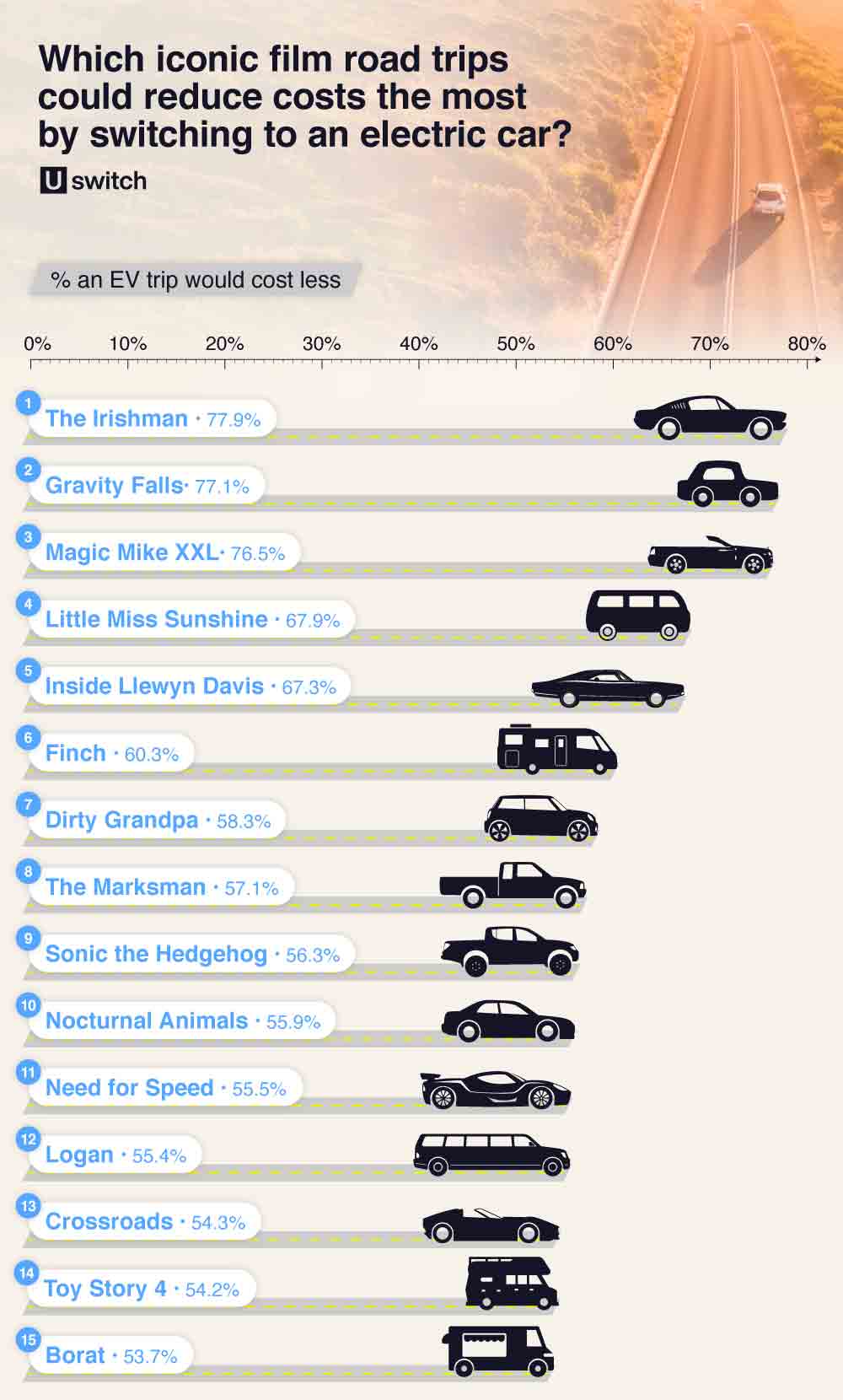Iconic road trips driven in EVs: emissions could be reduced by half, data reveals
From Easy Rider to On the Road, road trip adventures are a staple in Hollywood. But with characters often seen driving regular fuel-operated cars, how much CO2 could have been saved if they made the switch to an EV?
To answer this, the experts at Uswitch.com/electric-car analysed iconic road trips taken in films and TV shows to determine how many kilograms of CO2 emissions could be saved if the journey was made with an electric car instead of a regular petrol car.
analysed iconic road trips taken in films and TV shows to determine how many kilograms of CO2 emissions could be saved if the journey was made with an electric car instead of a regular petrol car.
The ResultsÂ
|
 |
Movie |
Money Saved (Euros) |
Carbon Saved (Kg) |
|
1 |
Toy Story 4 |
⬠220.37 |
611.01 |
|
2 |
Need for Speed |
⬠211.25 |
571.87 |
|
3 |
Borat |
⬠196.43 |
549.62 |
|
4 |
Crossroads |
⬠161.12 |
445.66 |
|
5 |
Finch |
⬠180.03 |
404.45 |
|
6 |
The Marksman |
⬠135.50 |
356.26 |
|
7 |
Logan |
⬠105.14 |
285.2 |
|
8 |
Sonic The Hedgehog |
⬠87.15 |
232.74 |
|
9 |
Little Miss Sunshine |
⬠71.61 |
158.5 |
|
10 |
Inside Llewyn Davis |
⬠69.66 |
155.57 |
|
11 |
Dirty Grandpa |
⬠47.44 |
122.18 |
|
12 |
Nocturnal Animals |
⬠42.97 |
115.45 |
|
13 |
The Irishman |
⬠59.75 |
115.21 |
|
14 |
Gravity Falls |
⬠56.98 |
111.05 |
|
15 |
Magic Mike XXL |
⬠55.18 |
108.36 |
Uswitch.com/electric-car  can reveal that, if driven in an electric car, Woody and Forkyâs road trip in Toy Story 4 (2019) could have saved a staggering 611.01kg of CO2 emissions - that's the carbon offset impact of 25.5 trees for a year! Toy Story fans who want to follow the characters' journey from Boston to San Francisco can expect to pay a third less (29.63%) in an electric car, saving â¬220.37 as opposed to buying fuel.
 can reveal that, if driven in an electric car, Woody and Forkyâs road trip in Toy Story 4 (2019) could have saved a staggering 611.01kg of CO2 emissions - that's the carbon offset impact of 25.5 trees for a year! Toy Story fans who want to follow the characters' journey from Boston to San Francisco can expect to pay a third less (29.63%) in an electric car, saving â¬220.37 as opposed to buying fuel.
Following in second is the iconic road trip from Need for Speed (2014). Crossing the US from New York City to San Francisco, driving this route in an electric car could save 571.87 kg of CO2 emissions (carbon offset impact of almost 25 trees for a year). Charging the battery (â¬169.39) would also cost the crew over half the amount (55.5 %) that it would if filling up their car with petrol (⬠380.64).
In third is Sacha Baron Cohenâs satiric road trip from New York City to Los Angeles in Borat (2006). This journey would emit 549.62 kg of #CO2��to drive from coast to coast, equating to 22.9 trees needing to be planted in a year to neutralise emissions. Costing â¬Â 169.39 to charge along the way, swapping to an EV would save 53.7 % of Cohenâs fuel budget (⬠196.43).
Magic Mike XXL's road trip comes in 15th place
At the bottom of the list, Channing Tatumâs road trip from Florida to South Carolina in Magic Mike XXL (2015) could save over 100 kilograms of carbon emissions (108.36 kg) â 2.4 % less than Gravity Falls in 14th. However, it's expected to save you ⬠55.19 when taken in an electric vehicle.Â

Tips for switching to an electric vehicle
Ben Gallizzi, energy expert at Uswitch , comments â¦
, comments â¦
âItâs clear to see how switching to an electric vehicle could benefit the planet when it comes to these Hollywood road trips. If this has made you interested in moving beyond a petrol or diesel motor, here are some tips for switching to an EV â¦
- Find the best one for youâto make sure youâre getting the right vehicle for your lifestyle, you can compare electric cars in terms of price, battery range, number of seats and top speed.
- Decide between EV charging cablesâYouâll need to be able to connect your EV to a charger at home so you can top up the battery, so itâs important to choose the right charging cable.
- Find nearby charging pointsâlike the characters in these iconic road trip films, you need to think about where youâll charge your car when youâre out and about.â
Methodology
- Uswitch.com/electric-car
 sought to determine how much CO2 emissions can be saved if iconic fictional road trips were taken with an electric vehicle (EV) instead of a traditional petrol car.
sought to determine how much CO2 emissions can be saved if iconic fictional road trips were taken with an electric vehicle (EV) instead of a traditional petrol car. - To do this, a seed list of movies and TV shows featuring iconic road trips was created using data obtained from multiple online articles including Buzzfeed
 Â and IMDb
 and IMDb . The location of departure and arrival of the road trips were then collected via reliable online sources.
. The location of departure and arrival of the road trips were then collected via reliable online sources. - Next, possible road trip routes for petrol cars were mapped using OpenRouteServices
 Â (ORS) API within Python to determine the following factors: journey distance, travel time, and refuelling time (based on the average petrol vehicle range).
 (ORS) API within Python to determine the following factors: journey distance, travel time, and refuelling time (based on the average petrol vehicle range). - Following that, each tripâs CO2 emissions were calculated using EEA
 Â data figures (122.3 grams per kilometre CO2 for a new passenger car). The tripâs fuel cost was also calculated from EIA
 data figures (122.3 grams per kilometre CO2 for a new passenger car). The tripâs fuel cost was also calculated from EIA  and EPA
 and EPA  data.
 data. - Possible road trip routes for electric cars taking into account recharging stations, were also generated using ORS API, and Open Charge Map to reveal the journey time required including charging wait time.
- Due to the varying range offered by electric vehicles, the bestselling EV of 2020
 , the Tesla Model 3 Long Range, was used as a benchmark. Its total effective range was obtained from Inside EVs
, the Tesla Model 3 Long Range, was used as a benchmark. Its total effective range was obtained from Inside EVs Â (358 miles).
 (358 miles). - Total EV charging costs were estimated at $0.28 per kWh
 . This was determined by the following formula: (Tesla Model 3 battery * 80 %) * number of charges (assuming each charge replenishes the battery from 10 % full to 90 % full).
. This was determined by the following formula: (Tesla Model 3 battery * 80 %) * number of charges (assuming each charge replenishes the battery from 10 % full to 90 % full). - Synthesising the metric above for petrol and electric vehicles, comparisons on cost, journey distance, time, and carbon emissions were made to reveal how much CO2 emissions can be saved if iconic fictional road trips were made using EVs.
- Data was collected on 02/03/2022 and is accurate of then.
Credit: https://www.uswitch.com/electric-car/ev-charging/iconic-film-road-trips-in-an-ev/





















































 Gütsel RSS Feed
Gütsel RSS Feed



















































